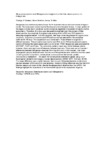Use este identificador para citar ou linkar para este item:
http://www.alice.cnptia.embrapa.br/alice/handle/doc/1037826| Título: | Metatranscriptomic and Metagenomic insights into the litter decomposition in mangroves. |
| Autoria: | TAKETANI, R. G.  MOITINHO, M. A.   MELO, I. S. de   |
| Afiliação: | R. G. TAKETANI, Bolsista FAPESP; M. A. MOITINHO, Bolsista CNPq; ITAMAR SOARES DE MELO, CNPMA. |
| Ano de publicação: | 2015 |
| Referência: | In: CONGRESSO BRASILEIRO DE MICROBIOLOGIA, 28., Florianópolis. Anais... Florianópolis: Sociedade Brasileira de Microbiologia, 2015. Ref. 1749-1. |
| Conteúdo: | Mangroves are costal ecosystems known for its important role as sink and source of organic matter. This ecosystem covers most of the tropical and subtropical shores. A major portion of the organic matter that is produced by the mangrove vegetation is exported to nearby marine ecosystems. Therefore, this study was designed to shed light over the process of litter decomposition by using high throughput sequencing of the mRNA and DNA present in decaying mangrove leaves. With this purpose, litter bags contatining leaves of Laguncularia racemosa, Avicennia schaueriana and Rhizophora mangle were left on the mangrove sediment for 60 days. This experiment was conducted in three different mangroves in different locations. These material was had its total DNA and mRNA extracted and used to construct libraries that were sequenced in an ion torrent PGM. Sequences were annotated by MG-RAST, CAZY and Crass. The community patterns were very similar between plants; however, there were significant differences between locations. There were some important differences between the groups observed for in the DNA and mRNA libraries. The major phylogenetic groups observed were Gamma and Deltaproteobacteria while the functions were clustering-based subsystems, carbohydrate, amino acid and derivatives, protein, miscellaneous metabolism. The search for carbohydrate metabolism genes using CAZY found genes related to plant organic matter decomposition (GH26, GH17, AA3 and GH43). The major difference was a switch between Gamma and Deltaproteobacteria as dominant classes between mRNA and DNA (respectively). Another striking difference was that the DNA libraries were much more similar, despite the geographical distance than the mRNA. Hits findings highlight the importance of environmental signals to the expression of genes. |
| Palavras-chave: | Metatranscriptomic Metagenomic Mangrove |
| Tipo do material: | Resumo em anais e proceedings |
| Acesso: | openAccess |
| Aparece nas coleções: | Resumo em anais de congresso (CNPMA)  |
Arquivos associados a este item:
| Arquivo | Descrição | Tamanho | Formato | |
|---|---|---|---|---|
| 2015RA014.pdf | 40,32 kB | Adobe PDF |  Visualizar/Abrir |









